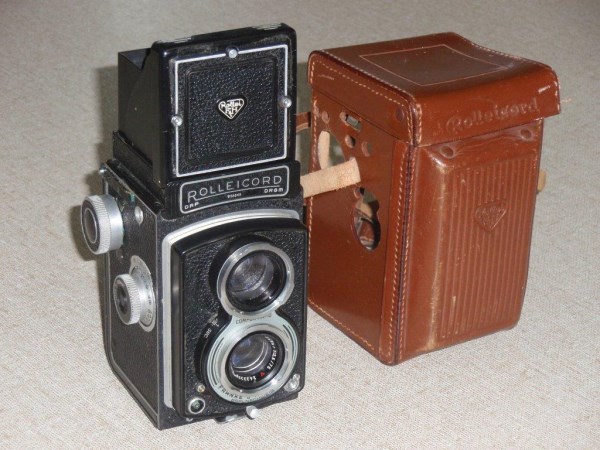
"Rollei Cameras"
Franke & Heidecke
(Braunschweig, Germany)
Franks & Heidecke was founded in 1920. The first product was the Heidoscop three-lens stereo camera, which remained in production from 1921 until 1941.
Both this camera and the Rolleidoscop stereo camera, which was introduced in 1926, already featured a reflex finder. The introduction of the Rolleiflex
TLR in 1929 was a breakthrough for the company. The 6x6cm Rolleiflex TLR was the first modern reflex camera and remains still in production today with
many improvements.
A small 4x4cm Rolleiflex appeared in 1931 with a film advance crank. This crank, subsequently fitted to all Rolleiflex cameras, was an important
technical advance. A cheaper line of TLR cameras called Rolleicord did not have this feature.
After WWII production of Rolleiflex and Rolleicord cameras was resumed. In a radical departure from their TLR cameras, Rollei introduced a line of
small and compact cameras. The first was the Rollei 16 of 1963, followed by the Rollei A110 in 1975. The year 1966 saw changes in the management and
brought the introduction of the first of a long series of Rolleiflex 6x6 SLR cameras, the Rolleiflex SL66. But Rollei's masterpiece was the Heinz
Waaske designed Rollei 35, which also was introduced at Photokina 1966 and was made in an improved version until c!999.
Two cameras for 126 film, the Rollei A26 and the Rolleiflex SL26 were high-quality products, but went out of production after the failure of the new
126 film format. The production of 35mm SLR cameras began in 1970 with the Rolleiflex SL35. At this period Rollei had great plans for the future and
decided to expand production considerably. Because of high wages this was not possible in Germany and the management decided to transfer part of the
production to Singapore in 1970. After the closure of Voigtldnder, Rollei bought in 1972 all of their cameras, production tools and the name
Voigtldnder. Financial problems began to pile up and in 1974 became serious. An ambitious program was planned. Cameras with new technology like the
SLX and the SL2000 appeared.
Cine cameras, projectors and flash units were built. But several changes in management could not avert bankruptcy in 1981. In 1982 a new much smaller
company with the name Rollei Fototechnic emerged from the ashes of the old Rollei-Werke. Production was in Germany only, except for Rolleinar lenses,
which were made in Japan. In 1987 Optische Werke Schneider-Kreuznach took over Rollei Fototechnic from United Scientific Holdings. Besides continuing
traditional mechanical cameras like the Rolleiflex 2.8G, different models of the SL66, and the Rollei 35 Classic, Rollei invested heavily in the
extremely modern successor to the SLX, the Rolleiflex 6008. Cameras sourced from Korea and Japan supplemented the traditional Rollei products.
Production of Rollei's last 35mm SLR, the Rolleiflex 3003 ended in 1994. In 1995 the Korean firm of Samsung took over Rollei to assure the future
development of Rollei Fototechnic. At the end of 1999, a group of employees took over the shares of Samsung. In 2002 the Danish investment trust
Capitellum took over 94% of Rollei. In 80 years Rollei-Werke Franke & Heidecke and its successors have built over 7,000,000 high-quality cameras.
 |
Stock No 4136
Rolleicord 111 Model K3B
Build in the 1950 s it has a Xenar3.5/75mm, Schneider, bayonet 1 finder lens,
It takes a 120 film with 12 exp
In very good condition
Make us an offer |
If this symbol
 is shown with a particular camera it indicates that I do not wish to sell it, however
if you really want to buy it, make me an offer.
is shown with a particular camera it indicates that I do not wish to sell it, however
if you really want to buy it, make me an offer.
|
|
Please Note:
A number of pages on this web site (www.ozcamera.com) contain a large number of photos, such pages may take a while to load
depending on the speed of the connection to your ISP.
If the data appears to stop loading, try holding down the "Shift" key and press the "Refresh" button in the View menu.
|
All Prices are shown in Australian Dollars
* * * * * * * * * * * * * * * * * * * * * * * * * * * * * * * * * * * * * * * *
The Internet links provided on any of my pages to other sites are provided as a matter of
convenience, and I don't necessarily endorse what you may find there.


